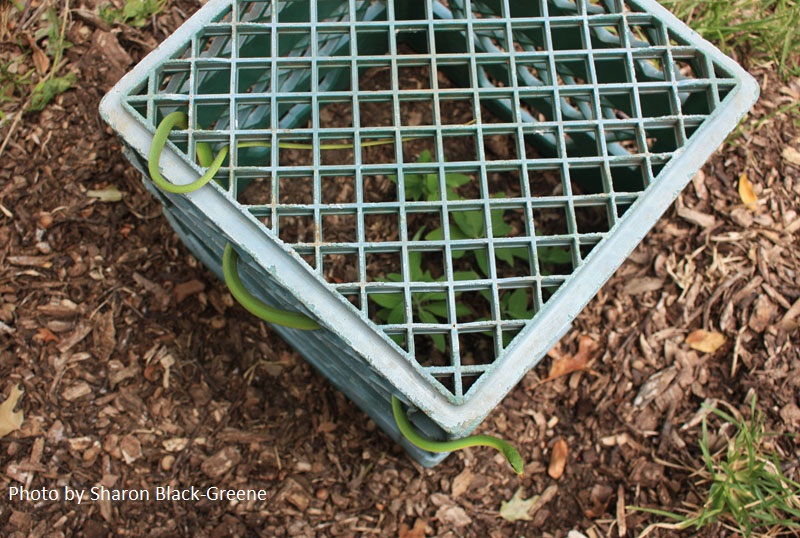November 19, 2015
Style Up for Drought and Edible Landscapes
Oh, how I love Barbados cherry! From spring through fall, it pumps out flowers for pollinators and edible fruits for us and eager birds. Designer Elizabeth McGreevy notes: “Did you know that back in the mid-1900s the U.S. considered it a food staple because of its vitamin C content?”

Since I planted red-veined sorrel a few years ago, it’s always a thrill to see it magically appear again every fall. I like its tangy flavor in salads but confess that the color’s what first grabbed me. Joining it here: rain lilies and Penstemon cobaea.

I’m planting oodles of annual calendulas. Long-lasting and tolerant of temperature swings until they finally give up in late May, I hope mine grow up as pretty as the ones at the American Botanical Council.

Hmm, I might add some borage like they did. What an eye-catching pair—that silvery borage and drooping lavender flowers against sprightly orange and yellow.

Gayle Engels’ recipe for calendula skin cream:
• Spread petals on paper towels to dry in a cool, dark place.
• Mix dried petals in a jar with the oil of your choice: olive, apricot, kernel or almond.
• Put in a cool, dark place and shake now and then for about six weeks.
• Strain. Use to soften skin or as healing balm for inevitable garden scratches.
We can eat the petals, while bees, butterflies and other tiny pollinators go for the nectar and pollen. Find out more on Down to Earth with Daphne.

When I tasted microgreens a few years ago, it was instant love. Growing your own is also inexpensive instant gratification and a fun indoor project for kids. Trisha’s got the tips for mini-harvests of tasty nutrition with bok choy, radish, arugula, sunflowers, peas, and lots more.

To protect crops from deer, squirrels, and birds, Viewer Picture goes to Sharon Black-Greene. She recycled a milk crate to fend deer from her young Mexican honeysuckle, a quick way to cover a few strawberries, too. Her helpful garden snake thinks she installed it for agility training.

Absolutely, the biggest change I’ve seen in just a few years is how gardeners are mingling food, herbs, and ornamentals, even in the front yard—rather than relegating each to its isolated bed in back.

To style up, color up and eat up in bountiful beautiful gardens. Tom meets with Adelante Landscape designer Cheryl Beesley, author of Landscaping with Edible Plants in Texas.


Her book covers it all, from design concepts to organic fertilizers, soil amendments, pest control and seed saving. And so much more!

Her illustrations make it so easy to prune fruit trees and create fruiting espaliers.

Cheryl magnifies forms and colors through fruiting trees, perennials and annuals.

And hey, she’s having a viewing party at noon this Saturday! Meet her at Tiniest Bar in Texas (managed by husband James) to talk edible plants over a plant-based beverage!

From flowers to food, our soil pH rules what we can grow. And ours is irrevocably alkaline. I’ve heard everything under the sun (or soil) about how to alter it. Forget the quick fixes and see why Daphne says “dance with the one that brung you.”

On tour, Linda Peterson matched a contemporary, energy-efficient house and serene courtyard with equally resourceful plants.

I first met this garden on a San Antonio Water Saver’s tour in fall 2014 and returned with director Ed and Daniel Veliz on a softly misting day last May. What a perfect moment to capture the intrinsic house and garden bond that Linda and Carl Peterson created!

They’d owned the property for years, giving them time to research the latest energy conserving architecture. Linda decided to go for water-thrifty outdoor design, too. Instead of lawn, they built a long-desired courtyard that preserves privacy on the corner lot.

Carefully, they preserved the live oaks’ heritage architecture.

Since many months call for outdoor dining and gatherings, they anchored the courtyard with a fireplace. Even when not in use, it’s naturally where people gravitate.



To ground the courtyard’s serenity, they chose Pennsylvania bluestone in a green hue.


Linda carried the flagstones to the front in a neighborly connection.


Before she was ready to plant, Linda used leftovers to define a tiny front yard secret garden. Its intent is to direct rainwater drainage and discretely provide privacy from the house next door (once theirs!).

To conserve water and attract pollinators, Linda paired drought-tough structural evergreens with softer perennials that make seasonal exclamations.



For a wrap-around walk, she punctuates standout notations with unifying swaths.


They made this neighborhood picnic table from an old gate at their former home next door.

In a shady, narrow back side garden, Linda created a cozy hangout where Pygmy bamboo gently screens.

It’s a great vantage point to watch the birds take a dip in her grandfather’s faux bois birdbath fountain.

A priority when they built the house was indoor/outdoor views with commercial energy-efficient windows. Linda wanted micro-patios to view from indoors or to step out from the kitchen or living room for an intimate garden respite. With a cattle panel screen, framed by fig ivy and flavored by hanging plants, they get a view to the garden without engaging in the neighbor’s life.


On another patio, she designed a screen from leftover metal roof panels.


There’s so much more, so here’s the whole story!
Thanks for stopping by! See you next time, Linda

